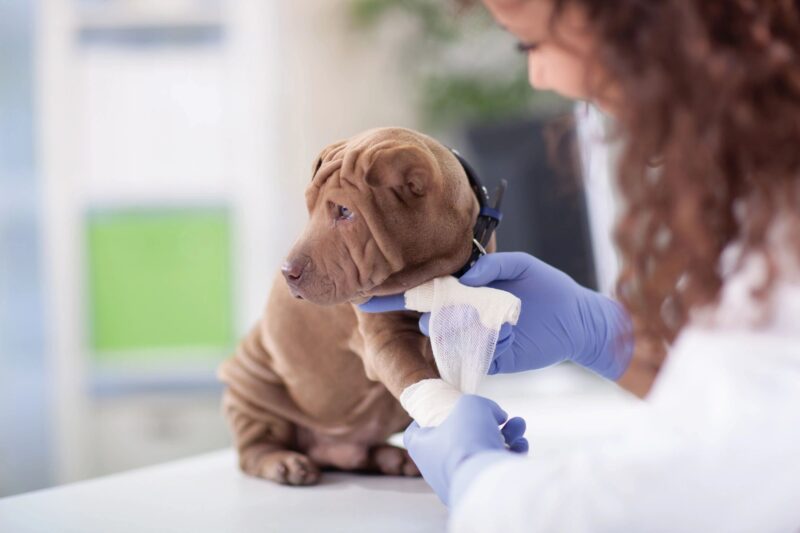- One: Remain calm and try to keep your pet calm. Approach your pet with caution. An animal in pain may bite or scratch.
- Two: If some sort of stabilization is possible (for example, direct pressure to slow down bleeding), try it—ideally while on the way to the veterinarian. If this is not possible, just get to the veterinarian as quickly as possible.
- Three: Even if your pet seems all right after an injury, take him or her to the veterinarian. Injuries involving an eye, the head, a large wound, breathing difficulty, sudden or severe swelling, pain, significant blood loss, or trauma (such as a car accident) should be seen immediately.
Dealing with an injured pet can be scary and frustrating. In many cases, you don’t know how bad the injury is, and your pet may not be acting normally. If your pet is injured, the first thing you need to do is try to remain calm. If possible, try to determine how severe the injury is, but remember that caution is extremely important when approaching an injured animal. Any pet, no matter how calm or friendly he or she may usually be, can bite or scratch when in pain.
While all injuries should be seen by your veterinarian as soon as possible, injuries involving an eye, the head, a large wound, difficulty breathing, sudden or severe swelling, pain, significant blood loss, or trauma (such as a car accident) should be seen immediately. Even if your pet appears to be normal after an accident, it’s possible for him or her to have internal injuries that you can’t see, so it’s important to go to your veterinarian as soon as possible.
What to Do Before Transporting Your Pet
In some cases, it’s obvious that your pet needs immediate transportation to your veterinarian for treatment. To reduce the risk of greater injury, however, you first need to stabilize your pet for transport.
If you think your dog may snap or try to bite because of pain, make a makeshift muzzle by wrapping something around the snout to hold the mouth closed. Be sure not to obstruct the nostrils! A necktie, stocking, belt, or long sock may work well. Wrap the muzzle, but don’t tie a knot—you may need to get it off in a hurry. If your pet is panting heavily or having problems breathing, don’t try to muzzle. Cats should not be muzzled.
If your pet is unable to move, you should handle him or her as little as possible to avoid further injury. Gently slide the pet onto a flat board, such as a piece of plywood covered with a blanket, and loosely strap him or her in place with tape or rope for transportation. For less serious injuries, try to scoop the pet up into a large blanket or towel and head for the car. If your cat becomes aggressive, use a towel or blanket (and thick leather gloves, if possible) to scoop him or her into a box or other sturdy container that restricts movement but has plenty of airflow.
Bleeding
If there is no apparent bleeding, take your pet to the veterinarian immediately. If there is quite a bit of bleeding, apply direct pressure to the wound. Sterile gauze is the best option, but a clean cotton T-shirt will also work.
Hold the material firmly in place until the blood clots. If the bleeding is on a limb or paw and it does not slow down after direct pressure, make a makeshift tourniquet and tie it between the wound and the heart. A tourniquet is simply something that wraps or ties around an area. It should be snug enough to compress the vessels and slow down blood flow, but not so tight that it is painful or can damage muscles or nerves in the area. You can use some of the same things you might use for a makeshift muzzle—a stocking, necktie, belt, or long sock will work. Be sure to loosen the tourniquet for 20 seconds every 5 minutes. Only use a tourniquet if absolutely necessary. A misapplied tourniquet can result in permanent disability or even the need for amputation. Never apply a tourniquet to your pet’s neck or tail.
Signs of internal bleeding aren’t always obvious, but they can include blood running from the nose, mouth, or rectum; coughing blood; blood in the urine; pale gums; or a rapid or weak pulse. In this case, minimize handling to prevent further damage, and keep your pet as warm, still, and quiet as possible on the way to the veterinary clinic.
Fractures
Without radiographs (x-rays), it may not be possible to tell if your pet has a fracture (a broken bone). If a limb is hanging or dangling, a fracture is likely. If your pet has a fracture, rest him or her on a flat, transportable surface, such as a piece of wood or tarpaulin, padded with blankets. You should not try to set a fracture. If you don’t know exactly where the break is (and how bad), you can make things worse. If a leg is clearly broken and the fracture is below the knee or wrist, you can try to wrap the area, first with cotton padding, then with something long and flexible, such as a magazine. This makeshift splint should extend one joint above and below the fracture. Secure it with tape and ensure that it is loose enough to maintain blood flow. If the fracture is above the knee or elbow, it will be very difficult to immobilize without making things worse, so just try to position the leg close to the body and get the pet to a veterinarian as quickly as possible. In most cases, it is best to handle the limb as little as possible and focus instead on getting your pet to the veterinary hospital.
If the injury is to an area that isn’t a limb, such as the spine, ribs, or hip, immobilize your pet as much as possible, carrying him or her on the transport that you created until he or she can be examined by your veterinarian.
Any injured animal, no matter how calm or friendly he or she may usually be, can bite or scratch when in pain, so use caution in handling an injured pet.
Burns
If your pet is burned with chemicals, flush the area immediately with large quantities of cool water. For burns from a heat source (fire, stovetop, etc.), gently flush with cool water or gently apply an ice pack wrapped in a soft towel.
Shock
Often, injuries can cause your pet to go into shock. The signs of shock can vary and may include a weak or forceful pulse, shallow or deep breathing, nervousness, and a dazed appearance. If your pet is in shock, keep him or her still, quiet, and warm and get to a veterinarian right away. If your pet is unconscious, keep his or her head level with the rest of the body and watch for signs of vomiting. If vomiting occurs, be prepared to tilt the head slightly below the rest of the body to prevent inhalation of the vomit, then return the head to the level position.
An Ounce of Prevention
To avoid panicking during a pet injury, prepare yourself ahead of time. Assemble a first aid kit that includes essential items like sterile gauze and bandage material, towels, and a thick blanket. In addition, know when your veterinarian’s office is open and the location of the nearest emergency clinic that is open after hours. Keep this information, including phone number and address, available where it’s easy to find.

